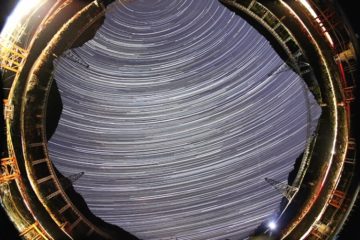Davide Castelvecchi in Nature:
 Gravitational waves are back, and they’re bigger than ever.
Gravitational waves are back, and they’re bigger than ever.
After the historic first detection of the space-time rattles in 2015 using ground-based detectors, researchers could have now rediscovered Albert Einstein’s waves with an entirely different technique. The approach tracks changes in the distances between Earth and beacon stars in its Galactic neighbourhood called pulsars, which reveal how the space in between is stretched and squeezed by the passage of gravitational waves.
Whereas the original discovery spotted waves originating from the collision and merger of two star-sized black holes, the most likely source of the latest finding is the combined signal from many pairs of much larger black holes — millions or even billions of times the mass of the Sun — slowly orbiting each other in the hearts of distant galaxies. These waves are thousands of times stronger and longer than those found in 2015, with wavelengths of up to tens of light years. By contrast, the ripples detected since 2015 using a technique called interferometry are just tens or hundreds of kilometres long.
More here.
